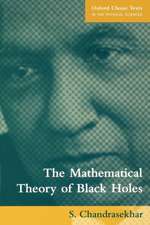Theoretical and Observational Problems Related to Solar Eclipses: Nato Science Series C:, cartea 494
Editat de Z. Mouradian, Magda Stavinschien Limba Engleză Paperback – 14 oct 2012
Din seria Nato Science Series C:
- 24%
 Preț: 797.69 lei
Preț: 797.69 lei - 18%
 Preț: 957.62 lei
Preț: 957.62 lei - 18%
 Preț: 957.13 lei
Preț: 957.13 lei - 18%
 Preț: 1227.52 lei
Preț: 1227.52 lei -
 Preț: 396.40 lei
Preț: 396.40 lei -
 Preț: 403.75 lei
Preț: 403.75 lei - 18%
 Preț: 1239.37 lei
Preț: 1239.37 lei - 18%
 Preț: 1236.51 lei
Preț: 1236.51 lei - 18%
 Preț: 1231.78 lei
Preț: 1231.78 lei - 18%
 Preț: 1229.10 lei
Preț: 1229.10 lei - 18%
 Preț: 1835.21 lei
Preț: 1835.21 lei - 24%
 Preț: 1076.39 lei
Preț: 1076.39 lei -
 Preț: 390.46 lei
Preț: 390.46 lei -
 Preț: 369.63 lei
Preț: 369.63 lei - 18%
 Preț: 1232.41 lei
Preț: 1232.41 lei -
 Preț: 394.51 lei
Preț: 394.51 lei - 18%
 Preț: 1226.24 lei
Preț: 1226.24 lei - 18%
 Preț: 1845.80 lei
Preț: 1845.80 lei -
 Preț: 399.88 lei
Preț: 399.88 lei -
 Preț: 384.28 lei
Preț: 384.28 lei -
 Preț: 390.88 lei
Preț: 390.88 lei -
 Preț: 381.19 lei
Preț: 381.19 lei - 18%
 Preț: 1848.64 lei
Preț: 1848.64 lei - 18%
 Preț: 951.14 lei
Preț: 951.14 lei - 18%
 Preț: 1230.35 lei
Preț: 1230.35 lei - 18%
 Preț: 1236.51 lei
Preț: 1236.51 lei -
 Preț: 401.03 lei
Preț: 401.03 lei -
 Preț: 406.25 lei
Preț: 406.25 lei - 18%
 Preț: 1230.84 lei
Preț: 1230.84 lei -
 Preț: 418.34 lei
Preț: 418.34 lei - 18%
 Preț: 1223.74 lei
Preț: 1223.74 lei
Preț: 387.96 lei
Nou
Puncte Express: 582
Preț estimativ în valută:
74.24€ • 80.89$ • 62.55£
74.24€ • 80.89$ • 62.55£
Carte tipărită la comandă
Livrare economică 23 aprilie-07 mai
Preluare comenzi: 021 569.72.76
Specificații
ISBN-13: 9789401063111
ISBN-10: 9401063117
Pagini: 292
Ilustrații: XVIII, 270 p.
Dimensiuni: 160 x 240 x 15 mm
Greutate: 0.41 kg
Ediția:Softcover reprint of the original 1st ed. 1997
Editura: SPRINGER NETHERLANDS
Colecția Springer
Seria Nato Science Series C:
Locul publicării:Dordrecht, Netherlands
ISBN-10: 9401063117
Pagini: 292
Ilustrații: XVIII, 270 p.
Dimensiuni: 160 x 240 x 15 mm
Greutate: 0.41 kg
Ediția:Softcover reprint of the original 1st ed. 1997
Editura: SPRINGER NETHERLANDS
Colecția Springer
Seria Nato Science Series C:
Locul publicării:Dordrecht, Netherlands
Public țintă
ResearchCuprins
Session 1: Principal scientifique results from the past eclipse observations.- Results from the coronal observations of the 1994 and 1995 total solar eclipses.- Distribution on halfwidths for the green coronal line (5303 Å).- Results of polarization observations of the white-light corona.- Distribution of polarization degree for the solar corona of 03 November 1994.- Fundamental contributions of the solar eclipse observations to solar physics in the second half of the 20th century.- Polarization of the 530.3 nm coronal line as observed on July 11, 1991.- Measurement of the coronal electron temperature at the total solar eclipse on 1994, November 3.- High resolution coronal imaging.- Session 2.: Small and large scale models of coronal structures.- Coronal physics inferred from the analysis of fine structures.- Radiative transfer in atmospheres with randomly distributed inhomogeneities.- Probing the solar atmosphere through radiophysics. A review of eclipse radio observations.- Computation of nonlinear force-free coronal magnetic fields: theory face to observations.- Comparing the large-scale coronal electron density distribution of the 1991 and 1994 solar eclipses.- 2D MHD numerical model for the study of dynamic and magnetic structures in the solar atmosphere.- MHD turbulences in the solar corona.- Post -flare loops in the chromosphere and corona.- Chromospheric and coronal heating mechanisms.- Reconstruction of the large-scale distribution of coronal electrons from eclipse data.- A new understanding of the coronal shape changes during the solar cycle.- Thermal evolution of a coronal condensation.- Medium and large scale structures of the low corona from decimeter and meter wavelength observations.- Session 3.: Low temperature structures in coronal environment.-Filament channels in the corona.- Faint “chromospheric” emission in the solar corona : observational and theoretical problems.- Creation of prominences and filaments — New vista on familiar sunscapes.- Unsolved problems in prominence research.- Session 4: Specific problems of solar eclipse observations.- Eclipse E-corona recording at far distances.- Simulation method to compute accurately the Einstein effect during a total solar eclipse. New ideas.- Emission line spectrum of the solar corona.- A possibility for studying subtelescopic structures in the solar corona.- Eclipse observations relevant to the coronal heating problem.- The indication of neutral hydrogen in the solar corona.- Relevant radio observations during a total solar eclipse.- Session 5.: Tasks for total solar eclipse of 11 August 1999.- NASA bulletin for the total solar eclipse of 1999.- Romanians prepararations for the’ 99 eclipse.- JOSO Working Group 7 : A focal point for collaboration around the 1999 solar eclipse.- A radio observation project for the 1999 solar eclipse.- Romanian projects for the 1999 total solar eclipse.- Session 6.: Instrumental improvement for future observations.- EIT, the Extreme-Ultraviolet Imaging Telescope on board SOHO:first results.- Objectives of a Ukrainian solar-oriented satellite.- A project for infrared observations during the total solar eclipses from the circumterrestrial orbit.- Session 7.: Public education at eclipse and eye safety.- Eye safety during solar eclipses — Myths and realities.- Solar eclipses as a vehicle for international astronomy education.- Variations of geophysical and biological parameters observed at a solar eclipse.- List of Poster Papers.- Notes on General Discussion.- Author Index.














